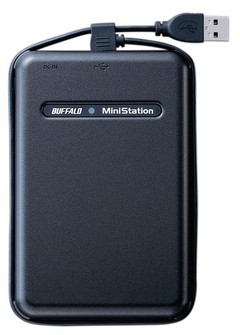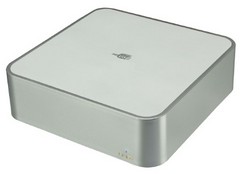Tag: Hard Drive
Alienware offering 640GB hard drive capacity in notebooks
Alienware has upgraded the hard drive capacity in its Area51 m9750 and Aurora m9700 notebooks PCs, claiming it's the first company to offer Samsung's 320 GB 2.5" hard drives in single and dual-device configurations, and able to be set up…
Shiny Video Review: Polaroid Click Free Media Backup – Photo Edition
Have friends who take a lot of photos and want to make backups but are a bit nervous of the whole drag and drop nature of most backup drives? Or they’re worried that they’ll forget to include something important? Well, this is the low-to-no intervention solution. It’s available exclusively at Boots the Chemist, for £89…
Buffalo intros TurboUSB-charged USB hard drives, speedy file transfer and performance
 Buffalo Technology has announced the availability of an enhanced range of MiniStation and DriveStation products, now featuring TurboUSB technology which is supposed to significantly improve the speed of file transfers and overall performance.
Buffalo Technology has announced the availability of an enhanced range of MiniStation and DriveStation products, now featuring TurboUSB technology which is supposed to significantly improve the speed of file transfers and overall performance.
The TurboUSB MiniStation is a portable, shock-resistant USB 2.0 external hard drive, offering up to 64% better file transfer rates than traditional USB 2.0 hard drives. It features a wrap-around cable, tough armoured outer case, and shock-absorbent internal design, and is able to draw its power from the PC via a powered USB port or hub. It will come in 80GB, 120GB, 160GB, 250GB, and 300GB capacities.
Buffalo’s TurboUSB DriveStation is intended for users who want to easily back up their files, and boosts file transfer speeds by up to 37%. It comes in capacities of 250GB, 320GB, 500GB, 750GB, and 1TB. The unit features an auto-setup function, auto power-on, and auto-backup scheduling.
Price per GB of external hard drives drops by one-third in a year
Let's be honest, hard drives aren't exactly the sexiest bits of computer gear, but they're increasingly important as we download yet more data from the Net and have to store it. A new report from GfK shows that the price…
LINDY launches 3.5" USB Data Dock, add portable USB hub, card reader, hard drive to a PC
LINDY Electronics has launched its USB Data Dock, a peripheral which utilises a PC's spare 3.5 inch drive bay to allow users to easily add on a portable USB hub, 2.5 inch hard drive, and a memory card reader, in…
Fujitsu lining up gargantuan 1.2TB hard drives for notebooks
 Fujitsu’s found a way to start charging more money for hard drives – inventing a new technology to increase their capacity.
Fujitsu’s found a way to start charging more money for hard drives – inventing a new technology to increase their capacity.
We’ll copy the method it used directly from the Fujitsu announcement as, frankly, it’s all a bit bewildering. Apparently, “one-dimensionally aligned alumina nanohole patterns with 25nm pitch were produced to support one Terabit/in2 bit recording density.”
LINDY launches NAS enclosure matching Mac Mini
 LINDY has launched its latest enclosure designed to complement and sit underneath a Mac Mini, but usable by any home network configuration. It’s a NAS (Network-Attached Storage) device which is compatible with standard 3.5-inch ATA hard drives (which you supply yourself).
LINDY has launched its latest enclosure designed to complement and sit underneath a Mac Mini, but usable by any home network configuration. It’s a NAS (Network-Attached Storage) device which is compatible with standard 3.5-inch ATA hard drives (which you supply yourself).
It features a built-in FTP (file transfer) server allowing up to five consecutive users on a network connect, plus support for Samba server, and a password-protected browser-based user interface to allow configuration.
Samsung launch first hybrid hard drive
Samsung has claimed the world's first production hybrid hard drive, the MH80 coming with a standard hard drive and up to 256MB of OneNAND flash memory on board, that can provide faster response times under certain circumstances. The drive has…
Macworld 2007: G-MINI Mac mini-styled hard drive and hub
G-Technology have unveiled their G-MINI hard drive and hub, styled to stack underneath the Mac mini. G-MINI features up to a 750GB 7200RPM hard drive, plus a 3-port FireWire 400 repeater and a 3-port USB 2.0 hub….
CES 2007: Hitachi’s 1 Terabyte hard drive
Imagine how much stuff you could store if you had a one-terabyte hard drive. You don’t have to: Hitachi Global Storage has helpfully supplied some suggestions. 1TB is enough for 333,000 high-res JPG photos, two years worth of MP3 tunes,…

















